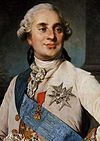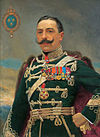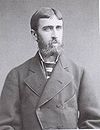Legitimists

The Legitimists (French: Légitimistes) are royalists who adhere to the rights of dynastic succession to the French crown of the descendants of the eldest branch of the Bourbon dynasty, which was overthrown in the 1830 July Revolution.[1] They reject the claim of the July Monarchy of 1830–1848 which placed Louis Philippe, Duke of Orléans, head of the Orléans cadet branch of the Bourbon dynasty, on the throne until he too was dethroned and driven with his family into exile.
Following the movement of Ultra-royalists during the Bourbon Restoration of 1814, Legitimists came to form one of the three main right-wing factions in France, which was principally characterized by its counter-revolutionary views. According to historian René Rémond, the other two right-wing factions were the Orléanists and the Bonapartists.[citation needed]
Legitimists believe that the traditional rules of succession, based on the Salic law, determine the rightful King of France. The last ruling king whom legitimists acknowledge as legitimate was Charles X, and when the line of his heirs became extinct in 1883 with the death of his grandson Henri, Count of Chambord, the most senior heir to the throne under these traditional rules was Infante Juan, Count of Montizón, a descendant of Louis XIV through his grandson Philip V of Spain. The fact that all French Legitimist claimants since 1883 have been members of the Spanish royal dynasty, the allegation that their patrilineal descent from Louis XIV has been in question since 1936, and the belief that Philip V renounced claims to the French throne for himself and his heirs-male in the Treaty of Utrecht, are all irrelevant to Legitimism; however, these facts have prompted other French monarchists to pivot to support of the Orléans line, who would be next in the traditional line of succession if Philip's heirs were excluded, or support to the Bonaparte family.
The current Legitimist pretender is Prince Louis, Duke of Anjou, the senior great-grandson of Alfonso XIII of Spain by male primogeniture, whose line was excluded from the Spanish succession due to the physical disability, political commitments, and morganatic marriage of Prince Jacques, Duke of Anjou and Segovia.
History
[edit]| Part of the Politics series |
| Monarchy |
|---|
 |
|
|
| This article is part of a series on |
| Conservatism in France |
|---|
 |
Bourbon Restoration (1814–1830)
[edit]Following the Bourbon Restoration in 1814, a strongly restricted census suffrage sent to the Chamber of Deputies an Ultra-royalist majority in 1815–1816 (la Chambre introuvable) and from 1824 to 1827. Known to be more royalist than the king (plus royalistes que le roi), the Ultras were the dominant political faction under Louis XVIII (1815–1824) and Charles X (1824–1830). Opposed to the constitutional monarchy of Louis XVIII and to the limitation of the sovereign's power, they hoped to restore the Ancien Régime and cancel the liberal, republican and democratic ideas of the French Revolution. While Louis XVIII hoped to moderate the restoration of the Ancien Régime to make it acceptable to the population, the Ultras would never abandon the dream of an integral restoration, even after the 1830 July Revolution which set the Orléanist branch on the throne and sent the Ultras back to private life in their country chateaux. Their importance during the Restoration was in part due to electoral laws which largely favored them (on one hand a Chamber of Peers composed of hereditary members and on the other a Chamber of Deputies elected under a heavily restricted census suffrage which permitted approximately 100,000 voters).
Louis XVIII's first ministers, who included Charles Maurice de Talleyrand-Périgord, Armand-Emmanuel de Vignerot du Plessis, duc de Richelieu and Élie, duc Decazes, were replaced by the Chambre introuvable dominated by the Ultras. Louis XVIII finally decided to dissolve this chaotic assembly, but the new liberals who replaced them were no easier to govern. After the 1820 assassination of Charles Ferdinand, Duke of Berry, the ultra-reactionary son of the comte d'Artois (Louis XVIII's brother and future Charles X) and a short interval during which Richelieu governed, the Ultras were back in government headed by the Jean-Baptiste de Villèle.
The death in 1824 of the moderate Louis XVIII emboldened the Ultra faction. In January 1825, Villèle's government passed the Anti-Sacrilege Act which punished by death the theft of sacred vessels (with or without consecrated hosts). This anachronistic law (according to Jean-Noël Jeanneney) was in the end never applied (except on a minor point) and repealed in the first months of Louis Philippe's reign (1830–1848). The Ultras also wanted to create courts to punish radicals and passed laws restricting the press.
After the 1830 July Revolution replaced the Bourbons with the more liberal Orléanist branch, the Ultras' influence declined, although it survived until at least the 16 May 1877 crisis and 1879. They softened their views and made the restoration of the House of Bourbon their main aim. From 1830 on, they became known as Legitimists.
Legitimists under the July Monarchy (1830–1848)
[edit]During the July Monarchy of 1830 to 1848, when the junior Orléanist branch held the throne, the Legitimists were politically marginalized, many withdrawing from active political life. Until 1844, the situation was complicated by debate as to who the Bourbon heir was, as Charles X and his son, the Dauphin Louis-Antoine had both abdicated during the 1830 Revolution in favor of Charles's young grandson, Henri, Count of Chambord. Until the deaths of Charles X and his son in 1836 and 1844, many Legitimists continued to recognize each of them in turn as the rightful king, ahead of Chambord.
Legitimists under the Second Republic and the Second Empire (1848–1871)
[edit]The fall of King Louis Philippe I in 1848 led to a strengthening of the Legitimist position. Although the childlessness of Chambord weakened the hand of the Legitimists, they came back into political prominence during the Second Republic. Legitimists joined with Orleanists to form the Party of Order which dominated parliament from the elections of May 1849 until Bonaparte's coup on 2 December 1851. They formed a prominent part of Odilon Barrot's ministry from December 1848 to November 1849, and in 1850 were successful in passing the Falloux Law which brought the Catholic Church back into secondary education.
Through much of this time there was discussion of fusion with the Orléanist party in their common interest of a monarchical restoration. This prospect prompted several sons of Louis Philippe to declare their support for Chambord, but fusion was not achieved, and after 1850 the two parties again diverged. The most committed Orléanists supported the candidacy of Louis Philippe's third son, François d'Orléans, Prince of Joinville, for the presidency while the Legitimists largely supported allowing Louis-Napoléon Bonaparte to run for a second term. In spite of this support for Bonaparte's ambitions, they opposed his scheme to restore universal suffrage in the last months of 1851, and their leaders, like those of the Orléanists, were arrested during Bonaparte's coup.
The period of the Second Empire saw the Legitimists once again cast out of active political life.
Legitimists under the Third Republic (1871–1940)
[edit]Nevertheless, the Legitimists remained a significant party within elite opinion, attracting the support of the larger part of the remaining Ancien Régime aristocracy. After the Siege of Paris in 1870 and the 1871 Paris Commune, the Legitimists returned one final time to political prominence. The 8 February 1871 election, held under universal manhood suffrage, gave the National Assembly a royalist majority supported by the provinces while all the Parisian deputies were republican. This time the Legitimists were able to agree with the Orléanists on a program of fusion largely because of the growing likelihood that the Chambord would die without children. The liberal Orléanists agreed to recognize Chambord as king and the Orléanists claimant himself Prince Philippe, Count of Paris (1838–1894) recognized Chambord as head of the French royal house. In return, Legitimists in the Assembly agreed that should Chambord die childless, Philippe d'Orléans would succeed him as king.[citation needed] Unfortunately for French monarchism, Chambord's refusal to accept the tricolor as the flag of France and to abandon the fleur-de-lys, symbol of the Ancien Régime, made restoration impossible until after his death in 1883,[citation needed] by which time the monarchists had long since lost their parliamentary majority due to the 16 May 1877 crisis. The death of Chambord effectively dissolved the Legitimists as a political force in France.
Affected by sinistrisme, few conservatives explicitly called themselves right-wing during the Third Republic as it became a term associated with the counter-revolution and anti-republican feelings and by the 1900s was reserved for reactionary groups. Those Legitimists who had rallied to the Republic in 1893, after Chambord's death ten years before still called themselves Droite constitutionnelle or républicaine (Constitutional or Republican Right). However, they changed their name in 1899 and entered the 1902 elections under the name Action libérale (Liberal Action). By 1910, the only group which openly claimed descent from the right wing gathered only nostalgic royalists. From 1924 on, the term right-wing practically vanished from the parliamentary right's glossary.
By this time, the vast majority of Legitimists had retired to their country chateaux and abandoned the political arena.[citation needed] Although the Action française (French Action) remained an influential movement throughout the 1930s, its motivations for the restoration of monarchy were quite distinct from older Legitimists' views and Charles Maurras' instrumental use of Catholicism set them at odds. Thus, Legitimists participated little in the political events of the 1920s and 1930s, in particular in the 6 February 1934 riots organized by far-right leagues. The royalist aristocrats clearly distinguished themselves from the new ultra right which was influenced by the emerging movements of fascism and Nazism. However, Legitimists joined Maurras in celebrating the fall of the Third Republic after the 1940 Battle of France as a divine surprise and many of them entered Philippe Pétain's Vichy administration, seeing a golden opportunity to impose a reactionary program in occupied France.[citation needed]
Legitimists under Vichy and after World War II (1940–1989)
[edit]French royalism largely receded to irrelevance in World War II and beyond. While before World War II, many French conservatives and other members of the right also harbored royalist aspirations, conservative movements dropped this platform during and after the war. Charles de Gaulle's center-rightist Gaullism explicitly repudiated monarchism, and far-right organizations disdained the old aristocratic elite. According to historian René Rémond's studies of right-wing factions in France, Legitimists strongly supported the Vichy regime;[citation needed] nevertheless, they received little from the Vichy government, and the regime emphasized Catholic traditionalism rather than a return to aristocracy.
Legitimism revived after the Second World War for several reasons.
- In 1946, the senior Capetian heir, Infante Jaime, Duke of Segovia, the eldest surviving son of King Alfonso XIII of Spain, whom 13 years earlier had renounced his rights to the throne of Spain on account of his deafness, took up up the courtesy title of Duke of Anjou.
- The academic work of historians like Hervé Pinoteau, jurists like Guy Augé and Stéphane Rials or genealogists like Patrick Van Kerrebrouck challenging the Orléanist theses have received a certain response from the public.
- The positions taken by Henri d'Orléans, Count of Paris, in particular in favor of General de Gaulle, Algerian independence and François Mitterrand shocked certain royalists.
- During the Capetian millennium of 1987, the then senior Capetian heir, Alfonso de Bourbon, Duke of Anjou and Cadiz, elder son of the aforementioned Infante Jaime, made himself known by presiding over numerous commemorative ceremonies. In the wake of the Capetian millennium, media personalities like Thierry Ardisson popularized legitimist conceptions.
Since the accession of King Juan Carlos I of Spain in 1975, the senior Capetian heirs have not laid claim to the throne of Spain. The legitimist suitor having had French nationality (which he had had since birth, having a French mother) in 1987, and having passed it on to his son (the current suitor), certain arguments of the partisans of Orléans would have become obsolete.
According to René Rémond, Marcel Lefebvre's Society of Saint Pius X, founded in 1970, shares aspects with the Legitimist movement. Nevertheless, Legitimism is a largely spent force.
Legitimism from 1989 to present, under the pretendancy of Louis de Bourbon
[edit]Current legitimism has several instances:
- The private secretariat of Louis de Bourbon, which takes care of his public affairs (diary, outings and official participation in the various events to which he is invited).
- The Secretariat also manages the Prince's communication and in particular his official website www.legitimite.fr as well as his presence on social networks.
- On the cultural level, the Institute of the House of Bourbon (IMB) was founded in 1973 at the request of Jacques-Henri de Bourbon. It was recognized as being of public utility in 1997. Its honorary president is Prince Louis, Duke of Anjou and its president, Charles Emmanuel, Duke of Bauffremont (born 1946), who succeeded his father in this position. In order to make better known the work of the kings who made France, the IMB organizes symposiums, conferences, travel exhibitions, and various commemorations. It also has a sponsorship and heritage protection action (commemorative plaques, restoration of graves, monuments, etc.)
- The Union of Legitimist Circles of France (UCLF), founded in 1979 by Gérard Saclier de La Bâtie. Its objective is to encourage the study of French historical legitimacy and to make the monarchy known. It brings together a large number of associations and circles and organizes political training days and demonstrations.
- Le Cercle d'action legitimiste (CAL), founded in 2012 by Loïc Baverel. Originally conceived as a branch of the UCLF, Loïc Baverel wanted to change militant methods by creating his own Circle. The objective of the CAL is political and aims to professionalize the militant approach in order to promote legitimist principles.
Spanish Bourbons
[edit]A remnant of Legitimists, known as the Blancs d'Espagne (Whites of Spain), by repudiating Philip V's renunciation of the French throne as ultra vires and contrary to the fundamental French monarchical law, upheld the rights of the eldest branch of the Bourbons, represented as of 1883 by the Carlist pretender to the Spanish throne. This group was initially minuscule, but it began to grow larger after World War II due both to the political leftism of the Orléanist pretender Henri, Count of Paris and to the active efforts of the claimants of the elder line after extinction of the Carlist male line—Infante Jaime, Duke of Segovia, the disinherited second son of Alfonso XIII of Spain; and his son Prince Alphonse, Duke of Anjou—to secure Legitimist support, such that by the 1980s the elder line had fully reclaimed for its supporters the political title of Legitimists.[citation needed]
The Spanish-born Prince Luis Alfonso is the Bourbon whom the French Legitimists consider to be the de jure king of France under the name Louis XX. A 1987 attempt[2] by the Orléanist heir (and other Bourbons, none of the elder branch) to contest Louis-Alphonse's use of the Anjou title[3] and to deny him use of the plain coat of arms of France was dismissed by the French courts in March 1989 for lack of jurisdiction (the courts did not address the merits of the claims). He is a French citizen through his paternal grandmother and is generally recognised as the senior legitimate representative of the House of Capet.
Dynastic arguments
[edit]This article possibly contains original research. (October 2011) |
Legitimists consider the valid rationale for restoration and the order of succession to the French throne derives from fundamental laws of the Ancien Régime, which were formed in the early centuries of the Capetian monarchy.
According to these rules, monarchy is the basic form of government and the monarch the indispensable executive of government, succession to the throne being hereditary and passing by Salic primogeniture. Thus, females and any male who is not the premier né (i.e. the legitimate eldest descendant of the most senior Capetian line) are excluded from the throne. The king must also be Catholic.[dubious – discuss]
Other tenets of the legitimist position are the following:
- Continuity (or immediacy) of the crown as upon the death of a monarch his heir automatically and immediately becomes king without the need of any formal act of investiture and even if political circumstances would not allow him to actually take power.
- Unavailability (or inalienability) of the crown as it is not the personal property of the king, therefore nobody, not even the king himself, can alter the line of succession by abdication, renunciation, or appointment of an heir of his own choosing. This argument is crucial for Legitimists regarding the continuing validity of the rights of succession of the Spanish line of Philip V and his descendants. According to this view, Philip's renunciation of his rights of succession to the French throne in the Treaty of Utrecht of 1713 was null and void and therefore his descendants still retain their claim to the French throne ahead of the Orléans line.
It has been a point of contention within the Legitimist camp to what extent French nationality constitutes a precondition for royal succession. While adherents of the Spanish Anjou line argue that princes of foreign nationality can still succeed to the French crown,[4] others hold that French nationality of both the claimant and his ancestors is a requirement.[5][6]
List of Legitimist claimants to the French throne
[edit]In the 1870s, the rival Legitimist and Orléanist claimants agreed for the sake of restoration of the monarchy in France to end their rivalry. Philippe d'Orléans, Count of Paris and grandson of Louis Philippe I, accepted the prior claim to the throne of Chambord, who remained childless; Chambord in turn acknowledged that Philippe would claim the right to succeed him as heir, and after his death many Legitimists accepted the descendants of Philippe as the rightful pretenders and became known as Unionists.[7][8]
Those Legitimists who did not accept the Orléanist line as the successors of Chambord argued that the renunciation of the French throne by Philip V of Spain, second grandson of Louis XIV, was invalid; in 1883 (when Chambord died childless), the throne passed by right to Philip V's heirs in the male-line. In 1883, the senior male of the Spanish branch of Bourbons was Infante Juan, Count of Montizón. His father, Infante Carlos, Count of Molina (second son of Charles IV: grandson of Philip V), had lost Spain's throne in favour of his niece, the non-Salic heiress of his elder brother, Isabella II and his lineage became known as the Carlist pretenders in Spain.
When the Carlist branch died out in 1936, the French claim was reunited with that of the Isabelline Spanish line through her grandson Alfonso XIII of Spain, who was also (officially) the grandson of her consort Francisco de Asís, Duke of Cádiz (grandson Charles IV via his third son, Infante Francisco de Paula of Spain) and thus the most senior male-line descendant of Philip V (although by that time Alfonso had been dethroned by the Second Spanish Republic). The French and Spanish claims separated again at Alfonso's death as his eldest surviving son Infante Jaime, Duke of Segovia renounced his claim to the Spanish throne due to physical disability and some years later asserted a claim to the French succession based on Legitimist principles. The present French Legitimist claimant descends from Jaime while the present king of Spain descends from his younger brother Don Juan.[9]
| Claimant | Portrait | Birth | Marriages | Death | Claimed Coat of Arms |
|---|---|---|---|---|---|
| Louis XVI of France 1792–1793 |

|
23 August 1754, Versailles Son of Louis, Dauphin of France and Marie-Josèphe of Saxony, Dauphine of France |
Marie Antoinette of Austria 16 May 1770 4 children |
21 January 1793 Paris Aged 38 |

|
| Louis-Charles, Dauphin of France (Louis XVII) 1793–1795 |

|
27 March 1785, Versailles Son of Louis XVI of France and Marie Antoinette of Austria |
Never married | 8 June 1795 Paris Aged 10 |

|
| Louis XVIII 1795–1824 (King of France 1814–1815, 1815–1824) |

|
17 November 1755, Versailles Son of Louis, Dauphin of France and Marie-Josèphe of Saxony, Dauphine of France |
Marie Joséphine of Savoy 14 May 1771 No children |
16 September 1824 Paris Aged 68 |

|
| Charles X 1824–1836 (King of France 1824–1830) |

|
9 October 1757, Versailles Son of Louis, Dauphin of France and Marie-Josèphe of Saxony, Dauphine of France |
Marie Thérèse of Savoy 16 November 1773 3 children |
6 November 1836 Gorizia Aged 79 |

|
| Louis Antoine, Duke of Angoulême (Louis XIX) 1836–1844 |

|
6 August 1775, Versailles Son of Charles X and Marie Thérèse of Savoy |
Marie-Thérèse, Duchess of Angoulême 10 June 1799 No children |
3 June 1844 Gorizia Aged 68 |

|
| Henri, Count of Chambord (Henri V) 1844–1883 |

|
29 September 1820, Paris Son of Charles Ferdinand, Duke of Berry and Marie-Caroline of Bourbon-Two Sicilies, Duchess of Berry |
Marie Thérèse of Austria-Este 7 November 1846 No children |
24 August 1883 Schloss Frohsdorf Aged 63 |

|
| Infante Juan, Count of Montizón (Jean III) 1883–1887 |

|
15 May 1822, Aranjuez Son of Infante Carlos, Count of Molina and Infanta Maria Francisca of Portugal |
Maria Beatrix of Austria-Este 6 February 1847 2 children |
21 November 1887 Hove Aged 65 |

|
| Infante Carlos, Duke of Madrid (Charles XI) 1887–1909 |

|
30 March 1848, Ljubljana Son of Infante Juan, Count of Montizón and Maria Beatrix of Austria-Este |
Princess Margherita of Bourbon-Parma 4 February 1867 5 children Princess Berthe de Rohan 28 April 1894 No children |
18 July 1909 Varese Aged 61 |

|
| Infante Jaime, Duke of Madrid (Jacques I) 1909–1931 |

|
27 June 1870, Vevey Son of Infante Carlos, Duke of Madrid and Princess Margherita of Bourbon-Parma |
Never married | 2 October 1931 París Aged 61 |

|
| Infante Alfonso Carlos, Duke of San Jaime (Charles XII) 1931–1936 |

|
12 September 1849 London Son of Infante Juan, Count of Montizón and Maria Beatrix of Austria-Este |
Infanta Maria das Neves of Portugal 26 April 1871 No children |
29 September 1936 Vienna Aged 87 | |
| Alfonso XIII of Spain (Alphonse I) 1936–1941 |

|
17 May 1886, Madrid Son of Alfonso XII of Spain and Maria Christina of Austria |
Victoria Eugenie of Battenberg 31 May 1906 7 children |
28 February 1941 Rome Aged 54 | |
| Infante Jaime, Duke of Segovia (Jacques-Henri I) 1941–1975 |

|
23 June 1908, Segovia Son of Alfonso XIII of Spain and Victoria Eugenie of Battenberg |
First marriage Emmanuelle de Dampierre 4 March 1935 Rome Divorced on 6 May 1947[10] 2 children Second marriage (civil only, not recognized by the Church) |
20 March 1975 St. Gallen Aged 67 |

|
| Prince Alphonse, Duke of Anjou and Cádiz (Alphonse II) 1975–1989 |

|
20 April 1936, Rome Son of Infante Jaime, Duke of Segovia and Emmanuelle de Dampierre |
María del Carmen Martínez-Bordiú y Franco 8 March 1972 Royal Palace of El Pardo Divorced on 1982 and annulled in 1986 2 children |
30 January 1989 Beaver Creek Aged 53 |

|
| Prince Louis, Duke of Anjou (Louis XX) 1989–present |

|
25 April 1974, Madrid Son of Alfonso, Duke of Anjou and Cádiz and María del Carmen Martínez-Bordiú y Franco |
María Margarita Vargas Santaella 5 November 2004 Caracas 4 children |

|
Electoral results
[edit]These are the results for broadly Legitimist parties in French national elections.
| Election year | No. of overall votes |
% of overall vote |
No. of overall seats won |
+/– | Leader | |
|---|---|---|---|---|---|---|
| 1831 | 28,270 | 22.6 | 104 / 460
|
|||
| 1834 | 4,218 | 3.3 | 15 / 460
|
|||
| 1837 | 4,855 | 3.2 | 15 / 460
|
–
|
||
| 1839 | 8,655 | 4.3 | 20 / 460
|
|||
| National Assembly (French Third Republic) | ||||||
| 1871 | Unknown (2nd) | ? | 182 / 675
|
|||
| 1876 | 332,470 | 4.5 | 24 / 553
|
|||
| 1877 | 687,422 | 8.5 | 44 / 521
|
|||
See also
[edit]- Bonapartism
- Bourbon Restoration
- Carlism
- France in the long nineteenth century
- French dynastic disputes
- Fundamental laws of the Kingdom of France
- Line of succession to the French throne (Legitimist-Orléanist)
- Loyalism
- Miguelist
- Orléanist
- Party of Order
- René Rémond
- Reactionary
- Royalist
- Succession to the French throne
- Ultra-royalists
- List of movements that dispute the legitimacy of a reigning monarch
References
[edit]- ^ Atkin, Nicholas; Biddiss, Michael; Tallett, Frank, eds. (2011). "Legitimism". The Wiley-Blackwell Dictionary of Modern European History Since 1789. Malden: Wiley-Blackwell. p. 239.
- ^ "Lawsuit brought by the comte de Clermont against the duc d'Anjou (1988–89)". Heraldica.org. Retrieved 2 August 2014.
- ^ "Apanages in the French Monarchy". Heraldica.org. 22 April 2010. Retrieved 2 August 2014.
- ^ Sainty, Guy Stair. "The French Legitimist Case". Archived from the original on 13 June 2010.
- ^ A. Pedone, ed. Revue d'Histoire Diplomatique (1889). Volume 3. Société d'Histoire Générale et d'Histoire Diplomatique: Société d'Histoire Diplomatique. Paris (in French). p. 190. Retrieved 11 October 2011.
- ^ Velde, François (31 December 2004). "The Nationality Requirement in the French Succession laws". Heraldica'.' Retrieved 11 October 2011.
- ^ Sedgwick, Alexander (1965). The ralliement in French politics, 1890–1898. Cambridge, Massachusetts: Harvard University Press. p. 12. ISBN 9780674747517.
- ^ "Henri-Scipion-Charles, marquis de Dreux-Brézé".
- ^ There are however some legitimists who have questioned the claims of all pretenders from Alfonso XIII onward, as it is commonly believed that his father, Alfonso XII, was not the biological son of the Duke of Cadiz. If true, this would mean that Francisco de Borbón y Escasany, 5th Duke of Seville (great-great grandson of Cádiz's younger brother) is currently the true legitimist heir to the French throne.
- ^ McNaughton, C. Arnold (1973). The Book of Kings. Vol. 1. London: Garnstone Press. p. 432. ISBN 978-0-8129-0280-8.
External links
[edit]- Legitimists
- Political parties established in 1814
- French counter-revolutionaries
- Conservatism in France
- Monarchism in France
- Rival successions
- 1814 establishments in France
- Pretenders to the French throne
- Conservative parties in France
- Monarchist parties in France
- Right-wing ideologies
- Right-wing parties in France
- Far-right politics in France
- Catholic political parties
- Political parties of the French Empire
- Reactionary


